Florida Jellyfish To Look Out For

As the weather and the waters turn cooler, we Floridians begin to see an influx of a variety of new marine species when diving, swimming, or even just walking along the beaches. One common cool water current-rider we see is the jellyfish. During the hot summer months, those of us in South Florida and the Florida Keys don’t see many, if any, jellyfish. But as soon as the temperature drops a bit, we get visited on our dives and while walking along the shoreline from a few different kinds of stinging, stringy blobs. In this blog, we will not only explore some fascinating jellyfish facts in general, but we’ll also get to know the specifics about common jellyfish found in Florida.
Fun Facts about Jellyfish
- Jellyfish (scientifically named scyphozoa) actually predate dinosaurs by a long shot. They predate trees, mosquitos, and even sharks, too! While jellyfish fossils aren’t exactly prevalent, scientists have dated the existence of jellyfish to anywhere from 500-700 million years!
- Jellyfish are a type of zooplankton, a gelatinous zooplankton to be exact. Although, some animals we think are jellyfish aren’t really jellyfish—they’re from an order called siphonophores (a few we will review here), and are actually more closely related to coral.
- Most jellyfish are made up of 98% water and they have no spine, brain, or heart, though some jellyfish do have eyes.
- A group of jellyfish can be known as a bloom, a swarm, or a smack. If you come across a bloom of jellyfish, it’s probably best not to go swimming that way.
- Jellyfish are prey to a variety of animals such as tuna, sharks, sea turtles, penguins, and even other jellyfish. If a jellyfish washes onto the shore it can also be eaten by local mammals and birds. Even some humans enjoy jellyfish in their cuisine.
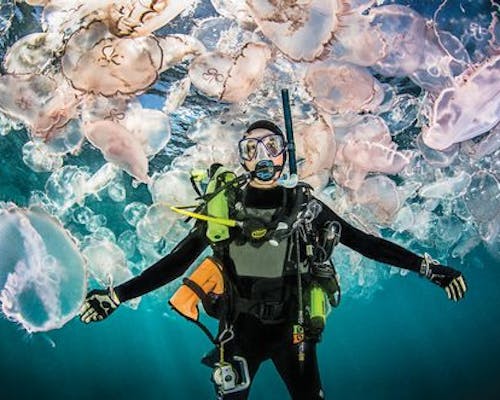
Jellyfish ExplorerEssentials
Five Common Jellyfish in Florida
Now let’s look into which types of jellyfish and other siphonophores we may frequently see in Florida during the winter months.
The Moon Jellyfish
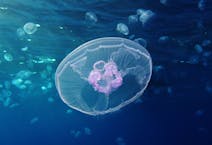
One of the most common types of jellyfish you’ll see out at sea around the Florida coast are moon jellyfish. A true jellyfish, the moon jellyfish (or moon jelly) can be huge, about the size of a large plate, and quite beautiful. They are recognized by their clear appearance, with four pink to purple rings within the body. They have a ring of short tentacles along the brim of their bell. Moon jellies are commonly seen drifting just below the surface of the water, so you’ll be able to spot them from your boat, kayak, or paddleboard. Around the winter months, these jellyfish are extremely common around the Florida Keys. They’re not venomous, but they can cause a stinging irritation on the skin if you make contact with them.
The Portuguese Man O’ War
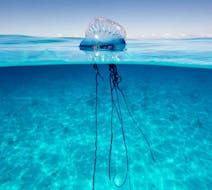
Our next winter stinger is one that you definitely don’t want to be around, and honestly, it’s not even a jellyfish. The Portuguese Man O’ War may look like a jelly, but it’s one of those siphonophores we discussed earlier. More closely related to coral, this creature is actually a colony of polyps that have banded together to achieve a common goal—survival. While most jellyfish swim along the ocean’s currents beneath the surface, this siphonophore hitches a ride with the wind. You can spot the Man O’ War cruising along the surface of the water, or you can observe it beached along a shoreline. Its fascinating swollen body acts as a sail while the long (30-100 ft), venomous tentacles collect food along the way. They’re easily spotted by their bright blue color and unique floating body shape. While rarely deadly, the pain that accompanies a brush up against a Man O’ War is intense. It’s best to stay far away when you see these animals floating around.
The By-the-Wind Sailor
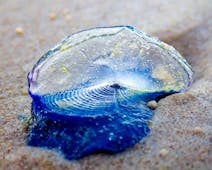
Next, let’s meet the by-the-wind sailor. The by-the-wind sailor has a wonderfully fun scientific name—velella velella—and they’re quite cute to look at as well, almost like little baby Man O’ Wars. They’re actually very similar to the Portuguese Man O’ War in that they aren't really jellyfish, but rather a colony of organisms working together to travel and eat. They are also similar in color and mode of travel to the Portuguese Man O’ War with their bright blue and clear sail floating along the surface, but they are much smaller with shorter tentacles and they pose little to no stinging threat to humans. They are usually smaller than around 4 inches, and since they use the wind to get around they are often found together in the hundreds or thousands after a windy storm has corralled them all together.
The Atlantic Sea Nettle
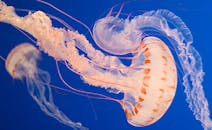
The Atlantic Sea Nettle is a common jellyfish (an actual jellyfish as opposed to the by-the-wind sailor and Portuguese Man O’ War) to be found around Florida coastlines. This jelly has a bell that’s about 5 to 7 inches in diameter and its tentacles can grow up to 20 inches as well. While mostly clear or cream colored, they are characterized by the brown-striped pattern along the bell. Their tentacles are designed to paralyze their prey, and while they won’t harm humans quite as badly, they’re still quite painful when touched. Best to just stay clear of these jellyfish all together just in case.
The Cannonball Jellyfish
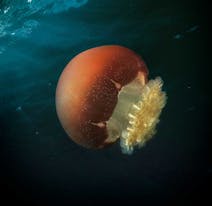
Finally, let’s take a look at the Cannonball Jellyfish. These bulbous jellies get their name from their shape and size, which is about the same as a traditional cannonball. Their dome’s diameter spans about 5 to 7 inches and they, unlike the Atlantic Sea Nettle and Portuguese Man O’ War, have rather short tentacles. Their little tentacles are made not only for capturing prey, but also for swimming. Unlike many other jellyfish, the cannonball jelly is a pretty excellent swimmer. The cannonball jellyfish, sometimes known as cabbagehead jellyfish or jellyball, that we see around the Florida coastline and throughout Atlantic waters tend to be a creamy white color with brown coloring around the rim of its bell. If you’re diving into some Pacific waters, though, you can see the Pacific cannonball favors the color blue. Since the toxins they use to injure their prey can cause mild irritation to humans, you may want to keep your distance when you see a cannonball jellyfish on the beach or in the water.
How to Protect Yourself From Jellyfish
If you see a beached jellyfish, protecting yourself is quite easy—simply don’t touch it. If it’s one of our longer tentacled friends mentioned here, keep a far enough distance so that a stray tentacle won’t make contact with you. Even if a jellyfish is beached,it can still sting you.
Protecting yourself from jellyfish while you’re in the water is a little more difficult, though not impossible. Whether you’re diving or swimming or surfing, sometimes you just happen upon a bloom or have a jellyfish sneak up on you by accident. This is where you may need some armor. Since our jellyfish friends tend to make their appearance in cooler waters, if we’re diving or surfing, we’re likely to already be wearing a wetsuit (a great protection against stinging jellies). Though, sometimes we may come across jellyfish in warmer waters where a rashguard or skin suit may be the perfect protectant while staying thermally comfortable.
Additional protection may come in the form of gloves, boots, or dive hoods. That way you’re covered from head to toe if you know you’re heading into particularly jellyfish abundant areas.
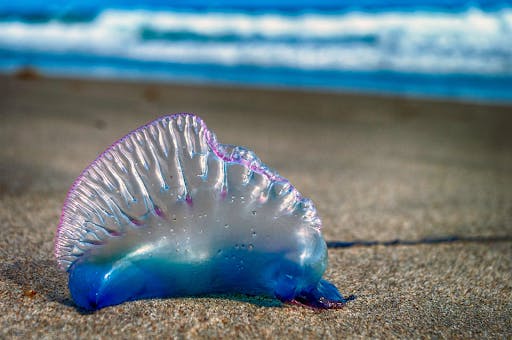
Time to round off our fun time of facts about jellyfish. What we’ve learned: these are beautiful and fascinating and sometimes very painful creatures. It is always beneficial to know how to identify jellyfish so that you can be more knowledgeable about the environment you're exploring, its inhabitants, and ways you can prevent injury. Thanks for being curious about jellyfish.
Written by Amy Baldacci
Jellyfish FAQs
Is it safe to scuba dive or swim with jellyfish?
This depends on the type of jellyfish you’re around and what sort of protection you’re wearing. It’s best not to swim or dive with highly venomous jellyfish at all.
How can I prevent jellyfish stings?
Wearing a wetsuit, rashguard, skin suit, gloves, hood, boots, and anything else that can put a barrier between your skin and a jellyfish tentacle is a great way to prevent stings while diving.
How long is a jellyfish's lifespan?
Depending on the species, jellyfish can be known to live for a couple of weeks to over a year.
If I see a jellyfish on the beach, what do I do?
If you see a jellyfish on the beach, it’s not like litter, there’s no need to pick it up. There’s also no need to take it back into the sea. It’s best to just leave it alone and keep walking. A beached jellyfish is either dead or dying and will serve as a meal for local terrestrial wildlife.
What do I need to know about jellyfish?
It’s always beneficial to know everything you can about an animal when you’re exploring its environment. The main things to know though include how best to respect an animal’s space and how to prevent contact or injury with a wild animal.
References:
Everything You Need to Know About Jellyfish In The Florida Keys
Secret Spot: Moon Jellyfish in Jupiter, FL
12 Fascinating Facts About Jellyfish
Corals and Other Invertebrates: Portuguese Man O’ War





